|

|
In January 2006, Andrew's seventh-grade class visited the Teng Chong area
to see the volcanoes and other geological features. Michael went as a
chaperone. The trip from Kunming took over 12 hours, partially because
(going) the police stopped traffic both ways for an hour after an
accident, and (returning) our bus had a flat tire. But we saw lots of
beautiful country along the way. (At the bottom of this page you'll find
an essay about Teng Chong from one of Michael's 2008 graduate students.)

It's impossible
to capture the breathtaking beauty of the scenery with a single photo here
and there. Putting three photos together like this helps, but not much!
This was taken from the side of the Da-Kong-Shan volcano.
|
|
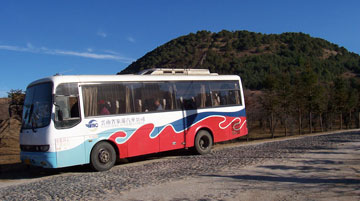
The school hired
this coach to take us from Kunming and back. We traveled all day Friday
and all day Sunday, with educational sightseeing all day Saturday. Here,
the bus is parked in front of Da-Kong-Shan volcano. We were impressed with
the first-class facilities (including the rest rooms!) at both of the
National Parks we visited (here and Re-Hai). But China is not the place to
visit if you don't like stairs!
(right) We
walked over a mile from the entrance of Da-Kong-Shan Park to the base of
the volcano, and then there were about 300 steps to take you to the top
(where you could descend into the crater). |
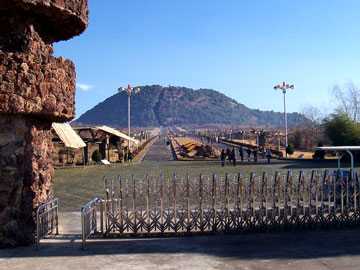
This is one of
five volcanoes (along with other natural features) in the Kong Shan
Volcano National Park. There are 20 or so volcanoes in the area, which has
also experienced over 70 major earthquakes in the past 500 years. I should
also note that, due to its altitude of 1650m, it reached zero (C) at night
but the kids were walking around in t-shirts at midday. |
|
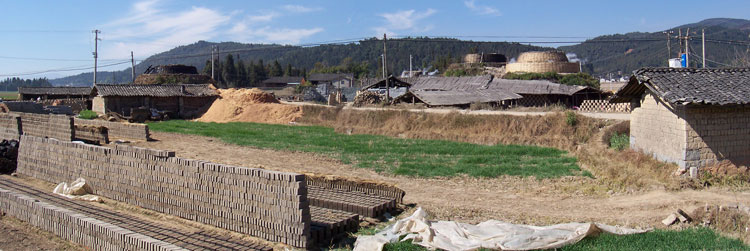
Along the road
there were a cluster of interesting brick kilns. Unlike the US, where
bricks are mainly used for decoration, Chinese bricks are an important
building material. |
|
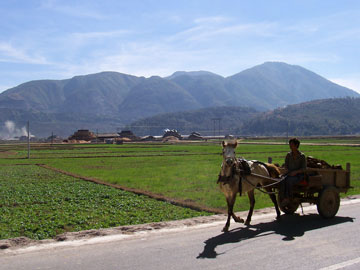
You can see more
kilns in the background. Those who travel in China also see all manner of
vehicles. Most are mechanical but we saw a number of horses, donkeys, cows
and water buffalo on this trip. The presence of slow-moving-vehicles on
narrow two-way roads is another reason for the long hours en route.
|
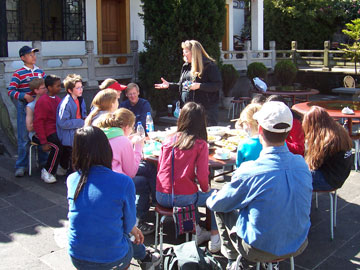
Since it was an
educational trip, the teachers took time to explain things when needed.
The students also had to fill out a few work sheets. This is at the
restaurant where we got four delicious meals. |
|
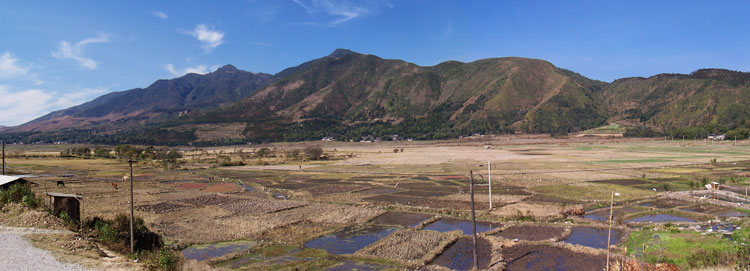
Here's another
composite photo, this time looking over the Bei-Hai marsh. Visitors who
have the time can take small boats into the glades. They say the area is
beautiful in the spring when all the orchids are blooming. I don't have
any photos of the beautiful new city streets in Teng Chong. Apparently the
government is working hard to encourage tourism to this remote area, only
a few kilometers from Myanmar. Another project is the rebuilding of an
airport used by the Flying Tigers of World War II (along with a museum,
scheduled to open in 2007). This was one of the first cities on the
Chinese side of the "hump," and American pilots flew vital supplies over
this dangerous air-route to help their Chinese comrades resist the
Japanese. |
|
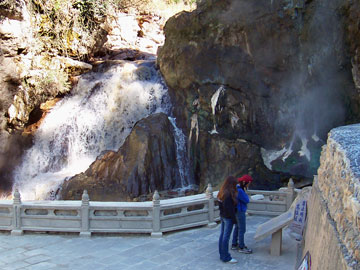
Another major stop was Re-Hai Hotsprings National Park.
Mineral-rich boiling water spews from the earth, and if you have the time
(and money) you can even swim in it. Again, there were lots of steps, nice
facilities, and lots of beautiful views of flowing or steaming water. |
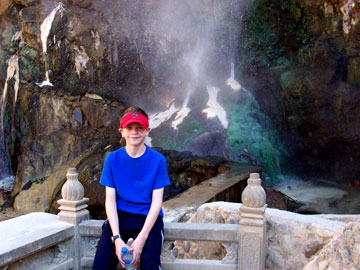
Andrew is sitting in front of a geothermal feature (also
seen in the left-hand photo) called
"the frog" because of the color produced by the minerals and temperature
of this geyser. |
|

Accidents
happen. We had a great bus driver, but the bumpy roads and construction
are bound to take their toll. Both tires blew, and the rest area
(providentially only a few hundred meters from the blowout) didn't have
the right size, so we experienced a two-hour delay, waiting for a bus to
take us to Dali and then another bus to get us back to Kunming. |
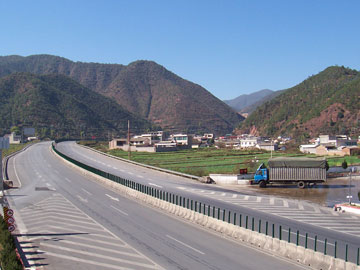
This beautiful
highway is an engineering marvel as it winds through the mountains. The
trip from Kunming to Dali took about 4.5 hours--it took 13 hours just a
few years ago. Then there was another two hours of high-speed expressway
to Baoshan, followed by about six hours over twisting two-lane mountain
roads to Teng Chong. But sooner or later the expressway is supposed to go
all the way to the border, helping China extend its prosperity to more and
more remote areas. (The essay below makes it sound like the work had been
completed by 2008.) |
|
Michael's
student at Kunming Medical University wrote the following essay about Teng
Chong (it has no English errors, and is a good example of an
academic
paragraph about change):
In the past few
years, Teng Chong County has attracted tourists by improving its
appearance, restoring historic structures and enhancing the traffic
infrastructure. In order to develop the tourism industry in Teng Chong,
many useless old buildings were removed and more trees have been planted.
This has made Teng Chong look clean and fresh. In addition, Teng Chong is a
city rich in culture and history. Therefore, a lot of old houses on the
main street have been rebuilt with wood instead of concrete and bricks.
Finally, the government has spent millions of dollars on traffic
infrastructure and has even built a highway leading directly to Myanmar
and then to India. This has made it convenient for people to travel abroad
to enjoy another totally different culture and environment. Teng Chong’s
greener appearance, less clutter, renovated wooden houses and increased
transportation options have contributed to helping this historic city
become a popular tourist destination in southwest China. (Rocky, 152
words, Dec 8, 2008)
Support points:
1. improved appearance (removed buildings, more trees)
2. restored historic structures (old-style wooden
structures, not concrete)
3. improved traffic
infrastructure (highway to Myanmar) |

Click in the boxes below to go to some of our most popular pages. If
you get lost, just click "Home."
See our
Policy
regarding the use of materials available at Krigline.com or
Krigline.com.cn
|










